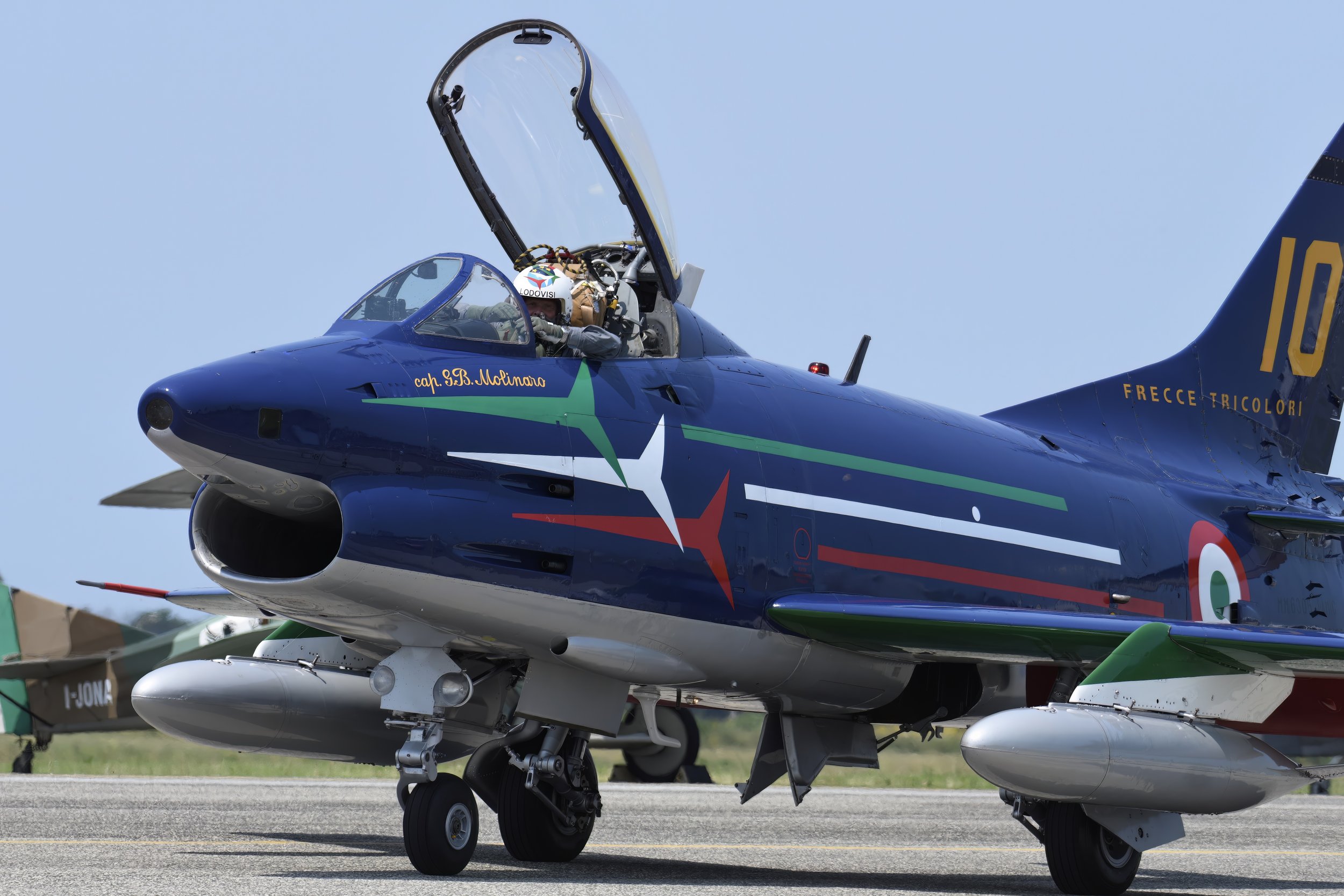
August 9 / Fiat G.91 first flight
First Flight 9 August 1956
Fiat G.91
The Fiat G.91, an iconic aircraft in the annals of aviation history, represents a significant milestone in the post-World War II era, particularly for European military aviation. Conceived in the early 1950s, the G.91 emerged from the NATO NBMR-1 (NATO Basic Military Requirement) competition, which sought a light, agile, and cost-effective jet fighter bomber to serve the alliance’s diverse air forces.
The origins of the G.91 can be traced back to the vision of Giuseppe Gabrielli, a renowned Italian aeronautical engineer who had previously designed the Fiat G.50 and G.55 during World War II. Gabrielli and his team at Fiat Aviazione set out to create a versatile aircraft that could fulfil multiple roles, including close air support, ground attack, and reconnaissance. The design philosophy emphasized simplicity, reliability, and ease of maintenance, which were crucial for the varied and often austere operating environments of NATO forces.
The prototype of the G.91, designated as the G.91R/1, took to the skies for the first time on August 9, 1956. It was powered by a single Bristol Siddeley Orpheus turbojet engine, which provided a balance of thrust and efficiency. The aircraft featured a sleek, aerodynamic design with a low-mounted wing and a distinctive T-tail configuration. Its compact size and lightweight construction contributed to its agility and performance, making it well-suited for the tactical roles envisioned by NATO.
In 1958, after rigorous testing and evaluation, the Fiat G.91 was declared the winner of the NATO competition, beating out several other contenders, including the French Dassault Étendard IV and the British Folland Gnat. This victory marked a significant achievement for the Italian aerospace industry and paved the way for the G.91’s adoption by multiple NATO member states.
The first production variants of the G.91 entered service with the Italian Air Force in 1961, followed by the German Luftwaffe and the Portuguese Air Force. Each country adapted the aircraft to its specific requirements, leading to the development of various sub-variants. The G.91R series, for example, was equipped with advanced reconnaissance equipment, while the G.91Y featured a more powerful engine and improved avionics.
Throughout its operational career, the G.91 demonstrated remarkable versatility and effectiveness. It saw extensive use in various conflicts and missions, ranging from close air support in the Portuguese Colonial War to reconnaissance flights during the Cold War. The aircraft’s rugged design and straightforward maintenance made it a reliable workhorse for NATO forces, earning it the nickname “Gina” among pilots and ground crews.
Despite its successes, the G.91 faced challenges as well. Advances in aviation technology and changing military doctrines eventually rendered the aircraft obsolete. By the late 1970s and early 1980s, many operators began phasing out the G.91 in favour of more modern and capable aircraft. However, its legacy endured, with several G.91s finding new life in civilian hands as warbirds and museum exhibits.
In conclusion, the Fiat G.91 stands as a testament to the ingenuity and resilience of post-war European aviation. Its development and operational history reflect the collaborative spirit of NATO and the strategic imperatives of the Cold War era. The G.91’s contributions to military aviation, particularly in terms of light attack and reconnaissance capabilities, continue to be remembered and celebrated by aviation enthusiasts and historians alike.
G.91 Facts
Design Influences: While the G.91 was an original design, it drew inspiration from several aircraft of the era, including the North American F-86 Sabre. Giuseppe Gabrielli and his team studied various successful jet fighters to incorporate the best elements into the G.91.
Aerobatic Team Use: The Italian aerobatic team, Frecce Tricolori, used the Fiat G.91PAN variant from 1963 to 1982. The aircraft’s agility and performance made it suitable for the precision manoeuvres required in aerobatic displays.
Operational in Africa: The G.91 saw combat action in Africa, particularly during the Portuguese Colonial War. It was used extensively by the Portuguese Air Force in operations in Guinea-Bissau, Angola, and Mozambique, where its ruggedness and versatility were put to the test.
Prototype Crash: The first prototype of the G.91, serial number MM.561, experienced a crash in 1957 due to engine failure. The pilot, Riccardo Bignamini, successfully ejected and survived, and the incident led to further refinements in the aircraft’s design.
German Production: The G.91 was not only produced in Italy but also under license in West Germany. Dornier, a German aircraft manufacturer, built a significant number of G.91s for the Luftwaffe, contributing to the aircraft’s widespread use within NATO.
Reconnaissance Pods: The G.91R variants were equipped with reconnaissance pods containing cameras and sensors. These pods could be easily swapped out, allowing the aircraft to switch between combat and reconnaissance roles quickly, enhancing its operational flexibility.
Engine Variants: While the G.91 primarily used the Bristol Siddeley Orpheus engine, the G.91Y variant was powered by two General Electric J85 engines. This twin-engine configuration provided improved performance and redundancy, making the G.91Y a more advanced version of its predecessor.
Survivability Features: The G.91 was designed with several features to enhance pilot survivability, including an ejection seat and built-in armour protection for the cockpit. These features were crucial for the aircraft’s role in close air support missions, where it often operated in hostile environments.
NATO Standardization: The selection of the G.91 by NATO was part of a broader effort to standardize equipment among member nations. This standardization aimed to simplify logistics and maintenance, allowing for more efficient support and interoperability during joint operations.
Civilian Use and Legacy: After being retired from military service, several G.91s found new life in civilian hands. Some were restored and flown by private collectors and aviation enthusiasts, while others were preserved in museums. The aircraft continues to be a popular subject among model builders and aviation historians, reflecting its enduring legacy.




